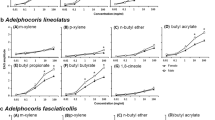Abstract
The sorghum shoot fly, Atherigona soccata, is an economically important pest of sorghum in Asia, Mediterranean Europe and Africa. Field observations have suggested that shoot fly susceptible sorghum varieties emit attractive volatiles, but the compounds involved were unknown. The objective of the present study was to identify plant-derived attractants for A. soccata. Headspace samples were collected from the susceptible cultivar ‘Swarna,’ and when female A. soccata were exposed to the volatiles in an olfactometer bioassay, a strong positive behavioral response was observed. Coupled GC-EAG with female A. soccata revealed eight compounds that elicited an EAG response, which were identified by coupled GC-MS and GC peak enhancement on two GC columns of different polarity as (Z)-3-hexen-1-yl acetate, (-)-α-pinene, (-)-(E)-caryophyllene, methyl salicylate, octanal, decanal, 6-methyl-5-hepten-2-one and nonanal. When an eight-component synthetic blend of the EAG active compounds, at the same concentration (2.64 μg) and ratio as in the natural headspace sample, was tested, A. soccata spent more time in the treated region of the olfactometer than controls (P = 0.001). Furthermore, when this synthetic blend and the natural headspace sample were tested in a choice test, the shoot flies did not show any preference for either of the two treatments, demonstrating that the synthetic blend had similar activity to the natural sample. Results are discussed in relation to breeding sorghum varieties less attractive to this pest.




Similar content being viewed by others
References
Agelopoulos, N. G., Hooper, A. M., Maniar, S. P., Pickett, J. A., and Wadhams, L. J. 1999. A novel approach for isolation of volatile chemicals released by individual leaves of a plant in situ. J. Chem. Ecol. 25:1411–1425.
Bruce, T. J. A. and Pickett, J. A. (2010) Perception of plant volatile blends by insects—finding the right mix. Phytochemistry.
Bruce, T. J. A., Wadhams, L. J., and Woodcock, C. M. 2005. Insect host location: a volatile situation. Trends Plant Sci. 10:269–274.
Deeming, J.C. 1972. Control of Sorghum Shoot Fly. Oxford and IBH Publishing Co. New Dehli.
Degen, T., Dillmann, C., Marion-Poll, F., and Turlings, T.C.J. 2004. High genetic variability of herbivore-induced volatile emission within a broad range of maize inbred lines. Plant Physiol. 135:1928–1938.
Dhillon, M.K., Sharma, H.C., Reddy, B.V.S., Singh RAM, Naresh, J.S., and Kai ZHU. 2005. Relative susceptibility of different male-sterile cytoplasms in sorghum to shoot fly, Atherigona soccata. Euphytica 144:275–283.
Gouinguene, S., Degen, T., and Turlings, T.C.J. 2001. Variability in herbivore-induced odour emissions among maize cultivars and their wild ancestors (teosinte). Chemoecology 11: 9–16.
Halitschke, R., Kessler, A., Kahl, J., Lorenz, A., and Baldwin, I.T. 2000. Ecophysiological comparision of direct and indirect defences in Nicotiana attenuata. Oecologia 124: 408–417.
Hiremath, P.S. and Renukarya, M.K. 1966. Occurrence, distribution and abundance of shoot fly on CSH 1. Sorghum Newsl. 9:37.
Icrisat 1992. Annual report 1991. International Crop Research Institute for Semi-arid Tropics, Patancheru, Andhra Pradesh, India.
Jotwani, M.G. 1982. Factors reducing sorghum yields—insect pests. In: Sorghum the Eighties. Proceedings International Symposium on Sorghum, 2–7 Nov, 1981. ICRISAT, Patancheru, pp 251–255.
Loughrin, J.H., Manukian, A., Heath, R.R., and Tumlinson, J.H. 1995. Volatiles emitted by different cotton varieties damaged by feeding beet armyworm larvae. J. Chem. Ecol. 21: 1217–1227.
Lupoli, R., Marion-Poll, F., Pham-Delegue, M.H., and Nasson, C. 1990. Effect d emissions volatiles de feuilles de mais sour les preference de Ponte chez Ostrinia nubilalis (Lepidoptera: Pyralidea). Comptes Rendus de l Academic des Sciences, Series 3. Sciences de la Vie 311: 225–230.
Lwande, W. and Bentley, M.D. 1987. Volatiles of Sorghum bicolor seedlings. J. Natl. Prod. 50: 950–952.
Nimbalkar, V.S. and Bapat, D.R. 1987. Genetic analyses of shoot fly resistance under high level of shoot fly infestation in sorghum. J. Maharashtra Agric. Univ. 12:331–334.
Nwanze, K.F., Nwilene, F.E., and Reddy, Y.V.R. 1998. Evidence of shoot fly Atherigona soccata Rondani (Dipt., Muscidae) oviposition response to sorghum seedling volatiles. J. Appl.Entomol. 122 : 591–594 .
Padmaja, P.G., Madhusudhana, R., and Seetharama, N. 2010. Sorghum Shoot Fly. Directorate of Sorghum Research, Hyderabad, India. ISBN 81-89335-29-4
Pettersson, J. 1970. An aphid sex attractant. Entomol. Scand. 1: 63–73.
Renwick, J.A.A. and Chew, F.S. 1994. Oviposition behaviour in Lepidoptera. Annu. Rev. Entomol. 39: 377–400.
Sukhani, T.R. and Jotwani, M.G. 1980. Efficacy of some newer systemic insecticides for the control of sorghum shootfly [Atherigona soccata (Rondani)]. Indian J. Entomol. 42:76–81.
Turlings, T.C.J., Lengwiler, U.B., Bernasconi, M.L., and Wechsler, D. 1998. Timing of induced volatile emissions in maize seedlings. Planta 207: 146–152.
Visser, J.H. 1986. Host odor perception in phytophagous insects. Annu. Rev. Entomol. 31,: 121-144.
Wadhams, L.J. 1990. The use of coupled gas chromatography: electrophysiological techniques in the identification of insect pheromones, pp. 289-298, in A.R. McCaffery, and I.D. Wilson (eds.). Chromatography and Isolation of Insect Hormones and Pheromones Plenum, New York.
Webster, B., Bruce, T.J.A., Dufour, S., Birkemeyer, C., Birkett, M.A., Hardie, J., and Pickett, J.A. 2008. Identification of volatile compounds used in host location by the black bean aphid, Aphis fabae. J. Chem. Ecol. 34: 1153–1161.
Webster, B., Bruce T.J.A., Pickett J.A. and Hardie J. 2010. Volatiles functioning as host cues in a blend become nonhost cues when presented alone to the black bean aphid. An. Behav.r 79: 451–457.
Acknowledgements
Rothamsted receives grant-aided support from the Biotechnology and Biological Sciences Research Council (BBSRC) of the United Kingdom. This work was supported by a Rothamsted International fellowship awarded to Poluru Padmaja. We thank ICRISAT for provision of sorghum seed.
Author information
Authors and Affiliations
Corresponding author
Rights and permissions
About this article
Cite this article
Padmaja, P.G., Woodcock, C.M. & Bruce, T.J.A. Electrophysiological and Behavioral Responses of Sorghum Shoot Fly, Atherigona soccata, to Sorghum Volatiles. J Chem Ecol 36, 1346–1353 (2010). https://doi.org/10.1007/s10886-010-9882-3
Received:
Revised:
Accepted:
Published:
Issue Date:
DOI: https://doi.org/10.1007/s10886-010-9882-3




